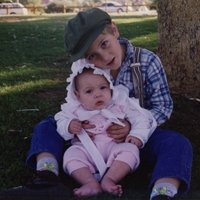
Monday, 18 October 2010
The feisty relationship between brothers and sisters and their family group has been a staple theme of television comedies for decades.
Yet the real-life relationships can be more subtle, affecting several aspects of siblings’ lives according to research being undertaken by researchers at the
School of Anatomy and Human Biology
.
A relatively small set of mammals – including humans -- live in more or less “nuclear” family groups.
The prolonged periods of social interaction within and among generations in a family has an impact on the development, adult life history strategies, and reproductive success of family members.
The lab group, led by Dr Debra Judge, focuses on the competition and cooperation of family members and the impact of these processes on growth, maturation, and variation in adult life.
Studies include:
- The dynamics of family living gibbons;
- How family conditions affect child growth in East Timor;
- The costs of brothers and sisters in Australian families;
- Patterns of intergenerational transfers; and
- The effects of early social life on cancer risks.
A study of Australian men and women recently published in the Royal Society’s Proceedings B journal found that even in contemporary Australia, siblings can affect each others’ maturation.
In polygynous mammals, there is evidence that male offspring are more costly than female offspring to their parents. Males are carried longer in utero, weigh more at birth and are nursed for longer than daughters.
In human studies of subsistence and pre-industrial societies, the higher costs of sons compared to daughters to the parents extends to a negative effect of brothers on the fitness and lifetime reproductive success of their siblings.
This negative effect is expected to be limited or non-existent in societies with fewer resource constraints. Using family composition and reproductive data from 273 adult Australians (197 females and 76 males), we investigate the cost of brothers in a contemporary western society.
Girls with elder brothers have an older age at first period (by 0.9 years) compared to girls with no elder siblings or girls with exclusively elder sisters.
Girls with younger brothers have an older age at first sexual intercourse (by 1.2 years) compared to girls with no younger siblings. Therefore, having elder brothers delays physiological maturation, while (presumably care-taking of) younger brothers delays behavioural maturation in the context of the natal family.
Fitness parameters, including age at first birth and parity, were not influenced by the presence or absence of younger or elder brothers in siblings of either sex.
In this contemporary low-fertility, low-mortality population, we find evidence of an early life cost of brothers to their sisters’ reproductive onset. However, this delay is not associated with a fitness cost in contemporary Australia.
We suggest that this is due to the prolonged period after leaving the natal home before the onset of reproduction.
That is, in populations with a younger average age at first birth, the childhood environment does influence age at first birth and parity.
While in populations with an older age at first birth (such as in contemporary Australia), there is a longer period of independence before starting a family so that sibling composition has a limited impact on adult reproductive behaviours.
We predict that sibling costs will occur in most societies, but that these early costs will only translate into actual fitness effects when the conditions of the natal family strongly influence the acquisition of mates and thus determine reproductive onset.
Writen by Fritha Milne and Debra Judge, the School of Anatomy and Human Biology
Tags
- Channels
- Research
- Groups
- Science Matters